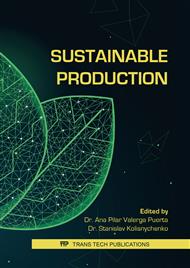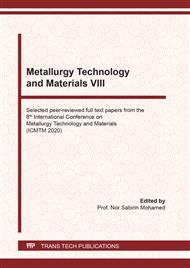p.3
p.10
p.16
p.25
p.31
p.37
p.43
p.50
Formation of Ferrosilicon Alloy at 1550°C via Carbothermic Reduction of SiO2 by Coal and Graphite: Implication for Rice Husk Ash Utilization
Abstract:
Ferrosilicon alloy has been commercially produced in an electric furnace at 1700 - 1750 °C, using quartz as a silica source. With an aim to reduce production cost, rice husk ash (RHA) had been introduced to the process as a silica source. The present study reports an in-depth investigation on the ferrosilicon alloy formation at 1550 °C via carbothermic reduction using RHA with coal and graphite. Blend A: RHA/Fe2O3/Coal and B: RHA/Fe2O3/Graphite were prepared according to the C/O molar ratio of 1/1. The well-mixed samples were compacted into a pellet and then heated at 1550 °C in the tube furnace for 30 and 60 minutes while the argon flowing at the rate of 1 L/min. XRD and SEM results show that the bulk metal mainly composes of FeSi phase, while SiC and other slag phases adhere at the surface of the droplet. Characteristics of the carbonaceous materials, especially ash oxides content affect the kinetic of ferrosilicon formation. Silicon concentration in the produced metal droplets was measured using an ICP technique. For blend A, Si content in the metal was 18.3 wt% and 81.9 wt% after 30 and 60 minutes, respectively. While, Si recovery in the metal for blend B reached 88.4 wt% since 30 minutes. The experimental results show that the production of ferrosilicon alloy from RHA can be produced at 1550 °C, which the temperature lower than that of the commercial method by 150-200 °C. The finding in this research is beneficial for ferrosilicon and agricultural industries and thus promotes the sustainable steelmaking industry.
Info:
Periodical:
Pages:
16-24
Citation:
Online since:
March 2021
Price:
Сopyright:
© 2021 Trans Tech Publications Ltd. All Rights Reserved
Share:
Citation:



